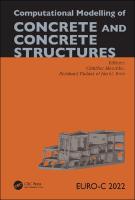Computational Modelling of Concrete and Concrete Structures
Proposal review
Contributor(s)
Meschke, Günther (editor)
Pichler, Bernhard (editor)
Rots, Jan G. (editor)
Language
EnglishAbstract
Computational Modelling of Concrete and Concrete Structures contains the contributions to the EURO-C 2022 conference (Vienna, Austria, 23-26 May 2022). The papers review and discuss research advancements and assess the applicability and robustness of methods and models for the analysis and design of concrete, fibre-reinforced and prestressed concrete structures, as well as masonry structures. Recent developments include methods of machine learning, novel discretisation methods, probabilistic models, and consideration of a growing number of micro-structural aspects in multi-scale and multi-physics settings. In addition, trends towards the material scale with new fibres and 3D printable concretes, and life-cycle oriented models for ageing and durability of existing and new concrete infrastructure are clearly visible. Overall computational robustness of numerical predictions and mathematical rigour have further increased, accompanied by careful model validation based on respective experimental programmes. The book will serve as an important reference for both academics and professionals, stimulating new research directions in the field of computational modelling of concrete and its application to the analysis of concrete structures. EURO-C 2022 is the eighth edition of the EURO-C conference series after Innsbruck 1994, Bad Gastein 1998, St. Johann im Pongau 2003, Mayrhofen 2006, Schladming 2010, St. Anton am Arlberg 2014, and Bad Hofgastein 2018. The overarching focus of the conferences is on computational methods and numerical models for the analysis of concrete and concrete structures.


 Download
Download